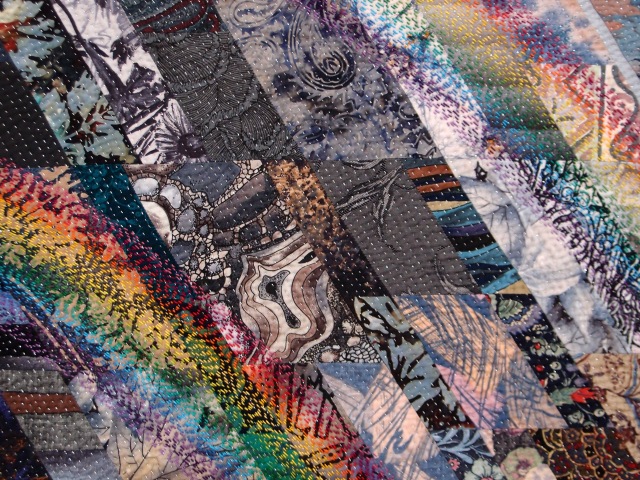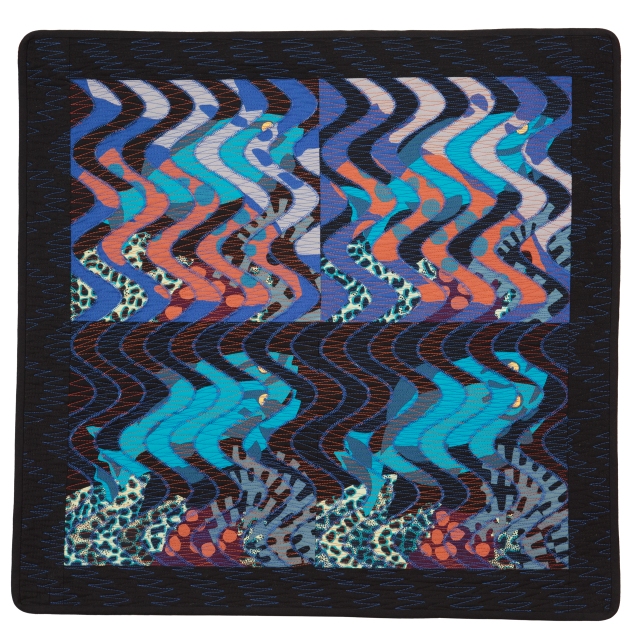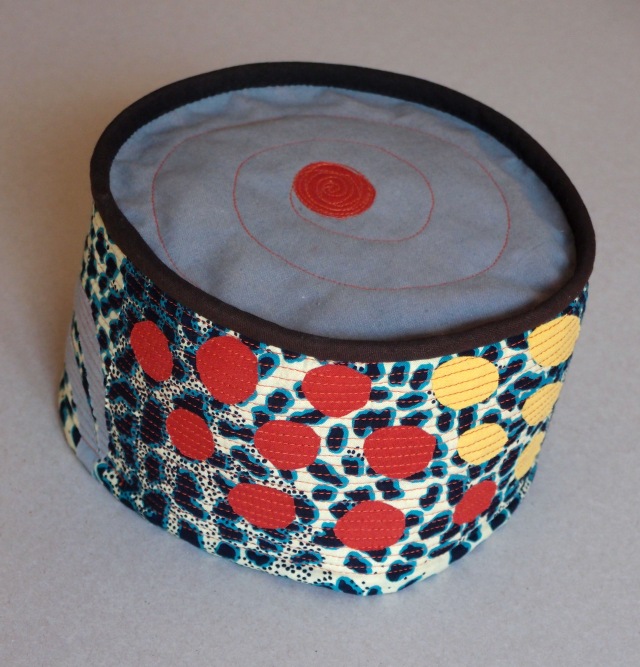Get to know The Guild better by meeting our talented members! We have interesting and inspiring members all over the country doing amazing sewing and we want you to be able to share their work.
Meet Guild member Deirdre Amsden, The Quilters’ Guild’s first ever President!
What are you working on now?
After twenty years of dividing my time between England, China and Australia – a barn renovation in Norfolk, porcelain in Jingdezhen and exploring a new country and culture from Bondi Beach – I am wondering whether to start quiltmaking again.
Since returning to the UK in 2012 I have been archiving a large collection; the remains of the TV satirical puppet show Spitting Image. The collection is now finally going on loan to Cambridge University Library, where it will be conserved and available for study.
Now I have time for sewing once again. I’m enjoying practicing long unused skills by finishing off unresolved pieces remaining after thirty years of quiltmaking. I have yet to decide if this will lead to new work.

Turn Around © Deirdre Amsden Started in October 1988 and finished in November 2017. 136cm x 105cm. Assorted cotton prints and cotton blends, machine pieced and appliqued and quilted by hand (coton perle).

Colourwash Waistcoat II © Deirdre Amsden. Started in 1998 and finished September 2017. 58cm x 51cm. Cotton lawn prints, hexagons pieced by hand and hand quilted with silk thread.

Rainbow Weather (detail) © Deirdre Amsden. Started in the 1990s and finished April 2018. 88cm x 185cm. Assorted cotton prints, machine pieced and hand quilted (silver metallic thread and coton perle).

The Granary, Wells-next-the-Sea © Deirdre Amsden, 2017. 20cm x 20cm. Assorted cotton fabrics, appliqued by hand.
What is your favourite quilt that you have ever made?
Night-time Blues and Blues in the Night are two quilts about a memory of stars that are now too often obscured by light pollution. As students returning from the pub along Suffolk lanes on a clear frosty night, looking forward to a steaming bowl of kedgeree, we walked gazing up at an East Anglian canopy of twinkling stars.
Travelling in the Australian outback I once again experienced the great dome of stars we all live under; this time the sky of the Southern Hemisphere. Unlike Suffolk of the 1950s we could follow the satellites…and it was warm.

Night-time Blues © Deirdre Amsden, 1987. 174cm x 216cm. Assorted cotton fabrics and cotton blends, machine pieced and hand quilted. Private collection. Photograph: John Coles.

Blues in the Night © Deirdre Amsden, 1991. 123cm x 152cm. Assorted cotton fabrics and cotton blends, hexagons pieced by hand and hand quilted. Private collection.
Who are your quilting heroes?
Although I had not seen any of Nancy Halpern’s quilts other than in reproduction I instantly liked them. I probably came across two of her early quilts, Hill Town, 1980 and Archipelago, 1983, in copies of the American Quilter’s Newsletter Magazine. These two quilts have lived in my head ever since. Eventually I did get to stand in front of Archipelago – a quilt of dreams – and if I were allowed only one quilt in the whole world to gaze upon, it would be this one.
Nancy Halpern’s quilts reflect her observations, discoveries and passions in life: autobiographical with the sensibility of an intelligent and thoughtful artist.
Pauline Burbidge has been making quilts since 1975 and I have enjoyed following her progress. Right from the start it was apparent that Pauline was a special person whose quilts could be made by no one else – her work, like Nancy’s, is autobiographical in feeling reflecting her changing interests and surroundings. I have always admired Pauline’s unwavering professional approach to her textile art.
I have gained a great deal of pleasure from Nancy and Pauline’s quilts. It is a rare talent, in this age of visual overload, to create images that long remain with the viewer. These two quiltmakers have done that for me – true artists both.

Fish Dance I, Pauline Burbidge, 1992. The Quilters’ Guild Collection.

Honesty Skyline, Pauline Burbidge, 2015. 164cm x 133cm. Cyanotype and mono printing techniques, hand stitched and hand quilted. The Quilters’ Guild Collection.

Pill Box Hat © Pauline Burbidge, collection Deirdre Amsden.
The Perfect Patchwork Primer by Beth Gutcheon published by Penguin Books, 1974.
This book shows my age but it was a key publication in the renewal of interest in quiltmaking in the 1970s, both in America and here in Britain. I am aware that books are no longer the preferred method of learning a skill but in the 1970s, in the absence of anyone to show us, this is how we taught ourselves to make quilts.
To quote Gutcheon “…the current patchwork boom is not a revival, an exercise in romance or nostalgia; rather it is a new and vigorous phase of a perennial American [also British] tradition, using different tools, expressing different aspects of ourselves, and based upon a different store of information.” Precisely.
Beth Gutcheon’s book confirms how the enthusiasm for quiltmaking returned from America to Europe during the lead up to the United States Bicentennial celebrations. The Pieced Quilt by Jonathan Holstein, published by New York Graphic Society in 1973 will add the colour plates to Gutcheon’s black and white book. Holstein’s/van de Hoof’s collection of quilts that travelled to Europe in the 1970s is often cited as the inspiration for many quilters of that era.
Amish Quilts and the Welsh Connection by Dorothy Osler published by Schiffer, 2011.
Enjoy Dorothy Osler’s lavishly illustrated book for it’s numerous colour plates of Welsh and Amish quilts but read it carefully for her meticulous research which presents a compelling argument for the influence of Welsh quilts on the early development of those classic Amish quilts made in Pennsylvania and Ohio in the nineteenth century.
Osler admits further local in-depth study is needed to “progress the research agenda” but why I find both books fascinating is the story of influences travelling from one group of people to another and the changes and developments that happen as a result. Witness textile designs between India and Britain as well as decorated porcelain between China and Europe.
One of the special aspects of making quilts is the sharing attitude of quilters. All artists beg, borrow and steal ideas then present them back to the world having made them their own but not all artists admit to this. Most quilters do.
After reading Dorothy’s book I started wondering about Welsh slate miners’ households where their wives would make quilts. The patterns found carved into slate fire surrounds found in cottages of North Wales often echo those of traditional Welsh quilting patterns. (See Carved in Slate by Tanya Harrod, Crafts magazine, No.72 January/February 1985).
When did you join the Guild and why?
At the inauguration meeting in 1979 about 50 people gathered in an upstairs room of the Crafts Council (then in Covent Garden) and decided to form a Guild of Quiltmakers. We had all been members of The Quilt Circle, which had started up approximately a year earlier.
It was only when the privately-run Quilt Circle began to fail that people wanted to find some way to remain in touch. The Quilters’ Guild was formed with a Steering Committee to oversee the setting up of a quarterly newsletter, the encouragement of a regional network and the organising of an exhibition and the first AGM. Founder membership was set at £6.
At the first AGM held in Winchester on 19 April 1980 the original officers of the Steering Committee were duly elected en bloc to continue running the Guild. I had been co-opted as President of the Steering Committee so on that day I became the Guild’s first President. That is the how, when and why I joined the Guild. At the AGM the membership fee went up to £7.50.
Deirdre Amsden
We are asking Members to tell us a bit about their sewing life using five simple questions. At the end of the interview each member suggests another to interview. This way we hope to bring you a wide range of makers from all corners of The Guild over the next weeks and months. If you know an inspiring quilter who we should feature, get in touch digital@quiltersguild.org.uk and we’ll send out a copy of our questionnaire.


Brilliant to see that Dierdre has come back to quilting and to see her new/old pieces.
LikeLike
Oh it was lovely reading this and I am so glad that Deidre has returned to making quilts. I joined the Guild very early after also being a Quilt Circle member! I doi wish they had chosen The Guild of Quiltmakers as it describes much more accurately what we are? Deidre has always been one of my favourite quiltmakers and I am also delighted that her choices are mine too!
LikeLike
I am so delighted that Deidre has come back to quilting. I worked with her when she was in Cambridge. Welcome back Deidre. Urszula
LikeLike
Its an huge honour to have know you even though we never met in person but you were friends with my Late Grandmother(Rennie Zulu). She used to speak about you a lot and seeing your name im reminded of her. Thanks very much and may God continue to bless you
LikeLike
Dear Siphiwe,
How lovely to hear from you…I am sorry I have been so long in replying but I didn’t know people were able to leave a message after reading ‘Meet a Member’. You are obviously still quilting. Are you a member of The Quilters’ Guild of the British Isles? As you never received the information I tried to send you about the Zamani Soweto Sisters Council perhaps I could try by email in a compressed file?
All my best wishes to you from Deirdre.
LikeLike